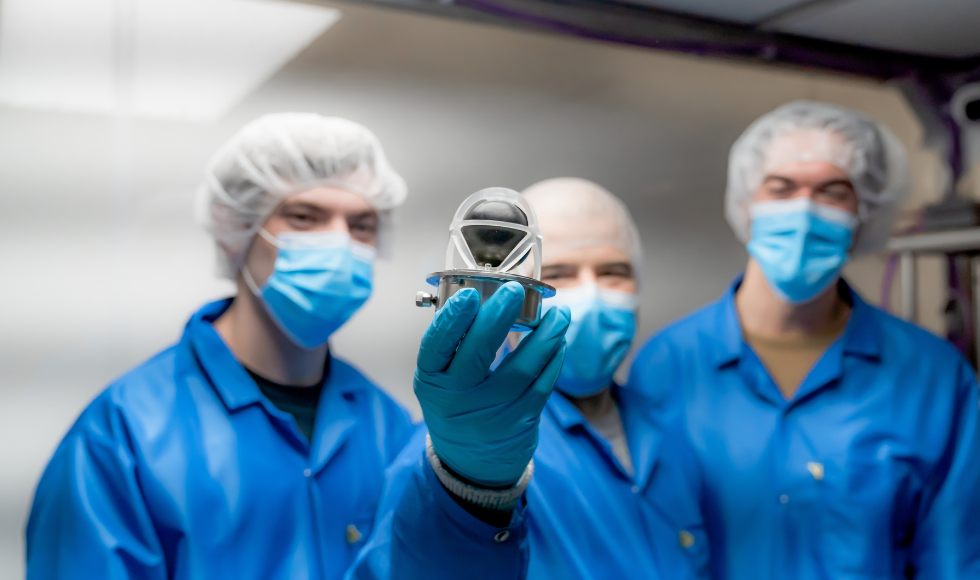Why study space radiation? To keep astronauts safe

A satellite built by McMaster students and researchers is heading into orbit to help protect astronauts as they travel further and stay out there longer. (Kayla Da Silva, McMaster University)
BY Jesse Dorey
March 10, 2023
With humanity eyeing space travel that would take astronauts beyond the low Earth orbit we’ve become accustomed to — say, on missions to Mars or beyond — it has become even more crucial to understand the long-term effects of space radiation.
For the last eight years, a team of students and researchers at McMaster have been building a satellite designed to do just that. And it’s about to launch into space on board a SpaceX rocket.
The satellite, named NEUDOSE — which is pronounced “new dose” and stands for Neutron Dosimetry (the measurement of radiation doses) and Exploration — is a state-of-the-art instrument capable of measuring the radiation levels that astronauts are exposed to in outer space.
But to understand why a satellite that’s barely the size of a loaf of bread is such a monumental achievement, we first need to understand why space radiation poses such a major risk to astronauts and how this satellite will help address those risks.
Meet the team, follow the launch: Inside McMaster’s first space mission
This little manoeuvre is going to cost us
“Just like the sun produces light that we can see down here on Earth, the sun’s also emitting particles that are traveling through space,” explains Eric Johnston, co-Principal Investigator for the NEUDOSE mission and a McMaster graduate.
In addition to this, stars and other objects also contribute to the overall radiation environment in outer space.
Here on Earth, the majority of these particles are stopped by the atmosphere.
But in space, that natural protection doesn’t exist, meaning these particles are free to interact with astronauts and spacecrafts.
“Without that extra protection we’re used to having, radiation is a lot more damaging to astronauts,” says Johnston.
Among other physiological effects, this damage includes the development of cancer, the formation of cataracts in the eyes, and cardiovascular issues, all of which can go undetected for years.
And for the NEUDOSE team, it’s not hard to imagine how this risk could be amplified on deep space missions.
Consider a human mission to Mars.
It could take astronauts upward of nine months to reach the planet. In that time, astronauts may receive a dose of radiation equivalent to what a human on Earth would receive in their entire lifetime, explains McMaster grad Andrei Hanu, co-Principal Investigator on the NEUDOSE mission.
Start factoring in time spent on the planet and travelling back to Earth and you can see why the effects of long-term exposure can be catastrophic.
Houston, we have a problem
But why is it so hard to protect humans from radiation in space?
According to Johnston, we get a reminder of it every time we go for an X-ray.
“If you imagine you’re going to get an X-ray at the hospital, they’ll put a lead vest on you,” he explains. “But there’s only so much lead and material we can bring up to space at any given time.”
There’s also the fact that we don’t really know much about the quality of radiation up there — that is, the types and amounts of radiation present in space.
“We’ve measured the bulk quantities to say, ‘Okay, we think it’s about this much damage,’” explains Johnston. “But the quality of radiation can really alter the long-term damage that might happen 20 or 30 years down the road.”
This gap in knowledge makes it extremely difficult for experts to adequately prepare astronauts for lengthy deep space missions.
“If we’re going to push astronauts further into space then we really need to understand the long-term effects of human space flight,” explains Johnston. “And to do that, we need to first know the quality of the radiation.”
This is the way
Shielding against all space radiation is an unrealistic goal, Hanu says.
But there may be a more effective way to mitigate its effects.
“A better approach would be to understand the space radiation environment,” explains Hanu.
Doing so would allow experts to understand the types and levels of radiation present during missions and prepare adequate protections for those exposure levels.
That’s where NEUDOSE comes in.
The state-of-the-art device comprises two separate instruments.
The first is a satellite that does everything you’d expect — namely, collect power from the sun and transmit data back to earth. According to Johnston, we can think of this instrument as the brains of the operation.
The second instrument is a novel radiation detector that is designed to measure space radiation and determine the type of radiation present as well as its dose, all in real -time. This device is one of the first tissue equivalent counters capable of measuring the quality of radiation.
The data it collects will be transmitted back to a ground station at McMaster, where researchers will analyze the data and use its measurements to understand the long-term effects of space radiation.
“Right now, this is a technology demonstration mission,” says Hanu. “But eventually NEUDOSE will be a standard radiation instrument for future missions to the Moon and eventually deep space.”
View this post on Instagram


